The Impact of Talent Management Strategies on the HR Function
VerifiedAdded on 2022/12/29
|44
|8750
|47
Report
AI Summary
This report, submitted as part of a research project, investigates the impact of talent management strategies on the role of Human Resources, using H&M as a case study. The report begins with a research proposal outlining the project's objectives, including identifying talent management concepts, contributions, and challenges faced by HR. The research explores literature on talent management, its contributions to HR, and challenges such as employee engagement and talent attraction. The methodology section details the research approach, including data collection and analysis. The report also examines the strategies H&M can use to manage talent, such as understanding job descriptions, assessing cultural fit, and providing training. The project includes a Gantt chart for time management, and the conclusion offers recommendations based on the research findings, followed by references and appendices. The report aims to provide insights into effective talent management practices and their influence on HR outcomes.

Unit 11– Research
Project
Project
Paraphrase This Document
Need a fresh take? Get an instant paraphrase of this document with our AI Paraphraser
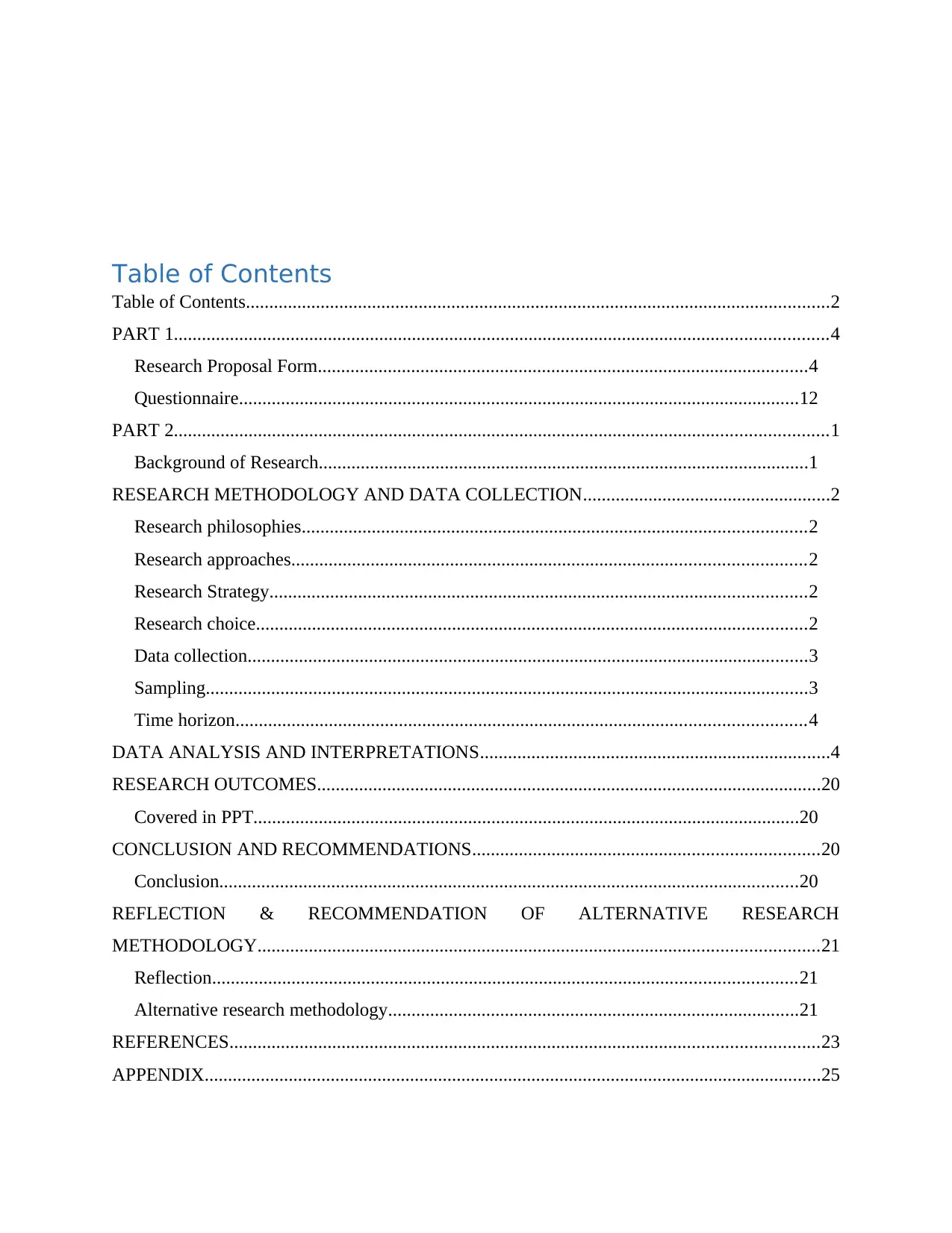
Table of Contents
Table of Contents.............................................................................................................................2
PART 1............................................................................................................................................4
Research Proposal Form.........................................................................................................4
Questionnaire........................................................................................................................12
PART 2............................................................................................................................................1
Background of Research.........................................................................................................1
RESEARCH METHODOLOGY AND DATA COLLECTION.....................................................2
Research philosophies............................................................................................................2
Research approaches..............................................................................................................2
Research Strategy...................................................................................................................2
Research choice......................................................................................................................2
Data collection........................................................................................................................3
Sampling.................................................................................................................................3
Time horizon..........................................................................................................................4
DATA ANALYSIS AND INTERPRETATIONS...........................................................................4
RESEARCH OUTCOMES............................................................................................................20
Covered in PPT.....................................................................................................................20
CONCLUSION AND RECOMMENDATIONS..........................................................................20
Conclusion............................................................................................................................20
REFLECTION & RECOMMENDATION OF ALTERNATIVE RESEARCH
METHODOLOGY........................................................................................................................21
Reflection.............................................................................................................................21
Alternative research methodology........................................................................................21
REFERENCES..............................................................................................................................23
APPENDIX....................................................................................................................................25
Table of Contents.............................................................................................................................2
PART 1............................................................................................................................................4
Research Proposal Form.........................................................................................................4
Questionnaire........................................................................................................................12
PART 2............................................................................................................................................1
Background of Research.........................................................................................................1
RESEARCH METHODOLOGY AND DATA COLLECTION.....................................................2
Research philosophies............................................................................................................2
Research approaches..............................................................................................................2
Research Strategy...................................................................................................................2
Research choice......................................................................................................................2
Data collection........................................................................................................................3
Sampling.................................................................................................................................3
Time horizon..........................................................................................................................4
DATA ANALYSIS AND INTERPRETATIONS...........................................................................4
RESEARCH OUTCOMES............................................................................................................20
Covered in PPT.....................................................................................................................20
CONCLUSION AND RECOMMENDATIONS..........................................................................20
Conclusion............................................................................................................................20
REFLECTION & RECOMMENDATION OF ALTERNATIVE RESEARCH
METHODOLOGY........................................................................................................................21
Reflection.............................................................................................................................21
Alternative research methodology........................................................................................21
REFERENCES..............................................................................................................................23
APPENDIX....................................................................................................................................25

⊘ This is a preview!⊘
Do you want full access?
Subscribe today to unlock all pages.

Trusted by 1+ million students worldwide
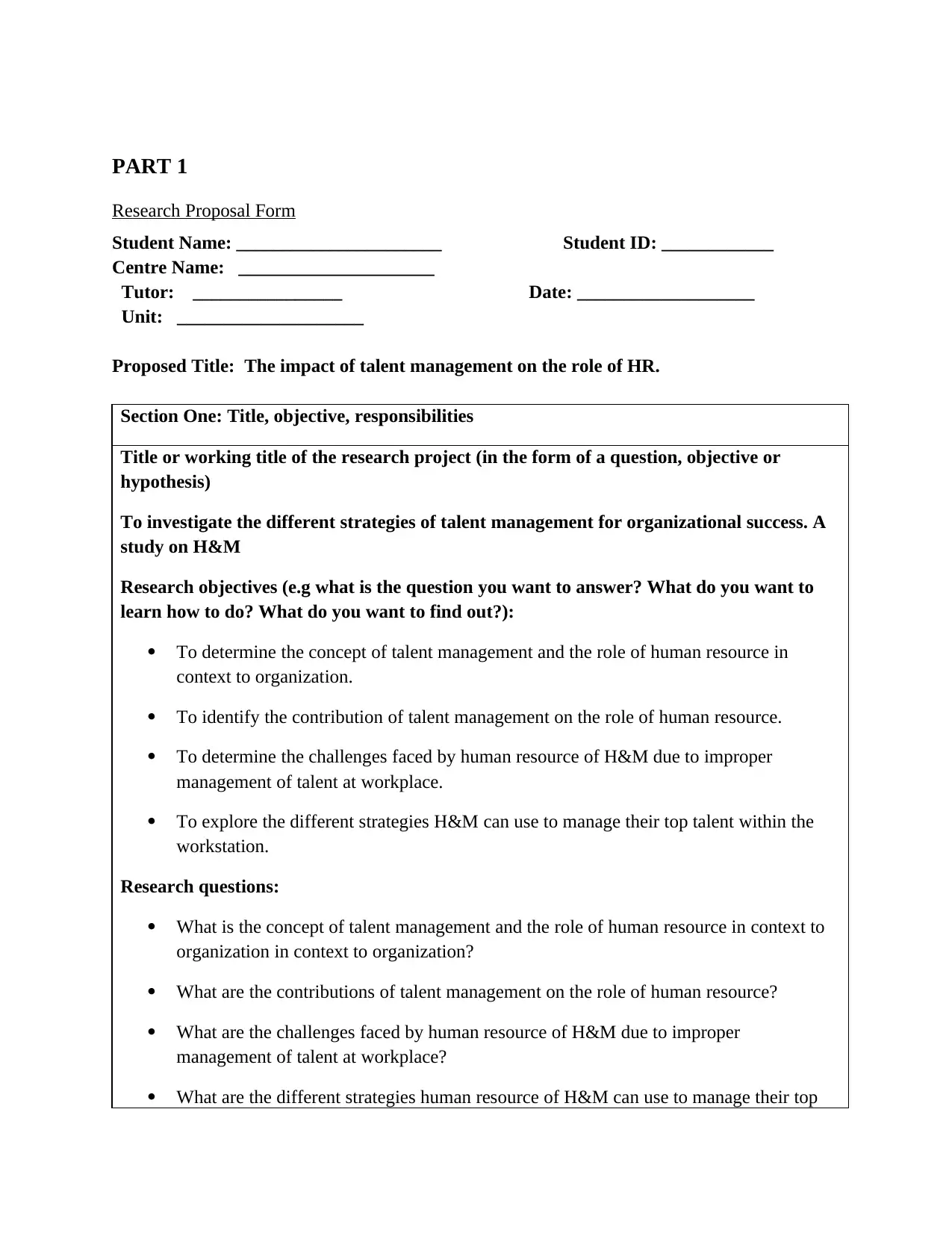
PART 1
Research Proposal Form
Student Name: ______________________ Student ID: ____________
Centre Name: _____________________
Tutor: ________________ Date: ___________________
Unit: ____________________
Proposed Title: The impact of talent management on the role of HR.
Section One: Title, objective, responsibilities
Title or working title of the research project (in the form of a question, objective or
hypothesis)
To investigate the different strategies of talent management for organizational success. A
study on H&M
Research objectives (e.g what is the question you want to answer? What do you want to
learn how to do? What do you want to find out?):
To determine the concept of talent management and the role of human resource in
context to organization.
To identify the contribution of talent management on the role of human resource.
To determine the challenges faced by human resource of H&M due to improper
management of talent at workplace.
To explore the different strategies H&M can use to manage their top talent within the
workstation.
Research questions:
What is the concept of talent management and the role of human resource in context to
organization in context to organization?
What are the contributions of talent management on the role of human resource?
What are the challenges faced by human resource of H&M due to improper
management of talent at workplace?
What are the different strategies human resource of H&M can use to manage their top
Research Proposal Form
Student Name: ______________________ Student ID: ____________
Centre Name: _____________________
Tutor: ________________ Date: ___________________
Unit: ____________________
Proposed Title: The impact of talent management on the role of HR.
Section One: Title, objective, responsibilities
Title or working title of the research project (in the form of a question, objective or
hypothesis)
To investigate the different strategies of talent management for organizational success. A
study on H&M
Research objectives (e.g what is the question you want to answer? What do you want to
learn how to do? What do you want to find out?):
To determine the concept of talent management and the role of human resource in
context to organization.
To identify the contribution of talent management on the role of human resource.
To determine the challenges faced by human resource of H&M due to improper
management of talent at workplace.
To explore the different strategies H&M can use to manage their top talent within the
workstation.
Research questions:
What is the concept of talent management and the role of human resource in context to
organization in context to organization?
What are the contributions of talent management on the role of human resource?
What are the challenges faced by human resource of H&M due to improper
management of talent at workplace?
What are the different strategies human resource of H&M can use to manage their top
Paraphrase This Document
Need a fresh take? Get an instant paraphrase of this document with our AI Paraphraser
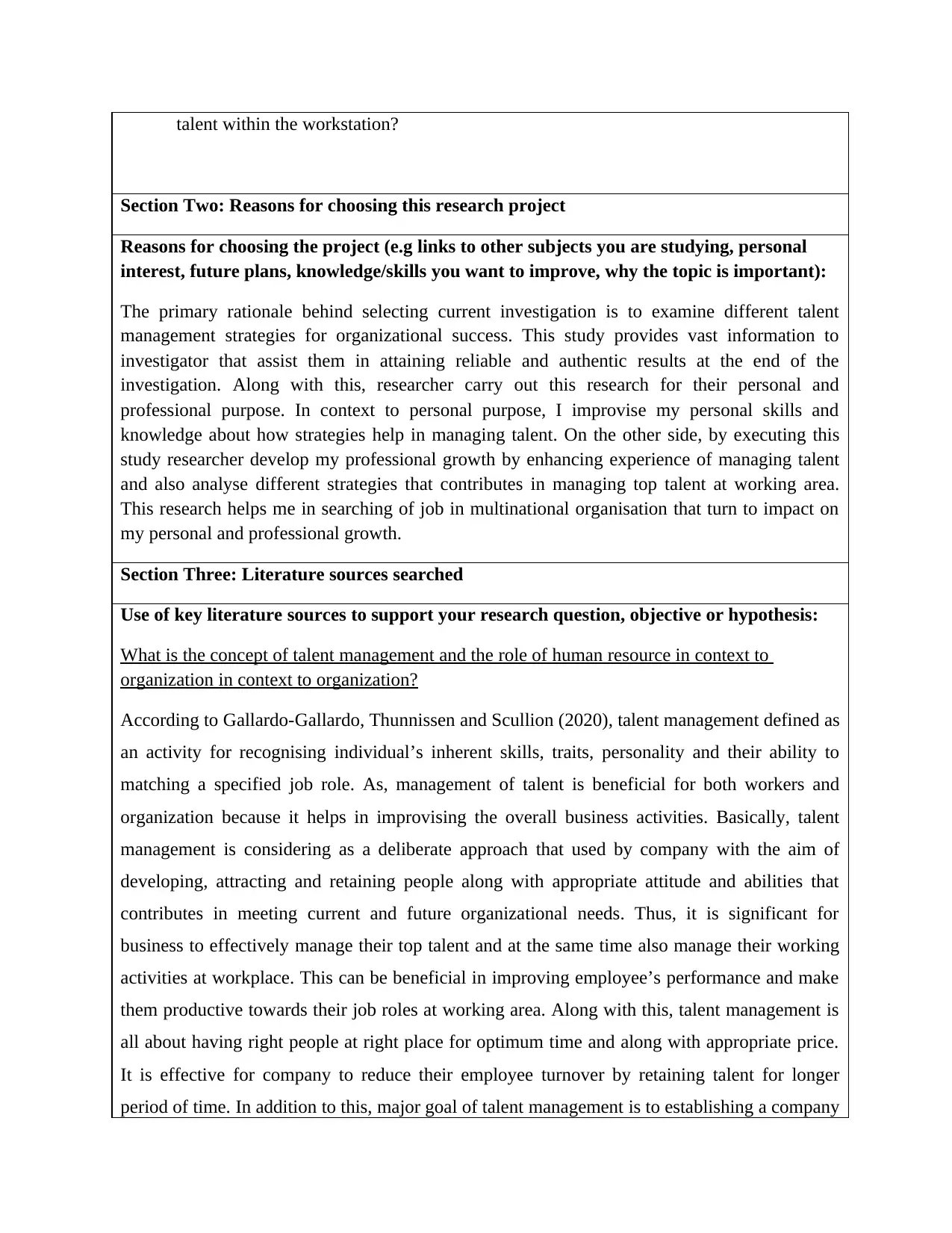
talent within the workstation?
Section Two: Reasons for choosing this research project
Reasons for choosing the project (e.g links to other subjects you are studying, personal
interest, future plans, knowledge/skills you want to improve, why the topic is important):
The primary rationale behind selecting current investigation is to examine different talent
management strategies for organizational success. This study provides vast information to
investigator that assist them in attaining reliable and authentic results at the end of the
investigation. Along with this, researcher carry out this research for their personal and
professional purpose. In context to personal purpose, I improvise my personal skills and
knowledge about how strategies help in managing talent. On the other side, by executing this
study researcher develop my professional growth by enhancing experience of managing talent
and also analyse different strategies that contributes in managing top talent at working area.
This research helps me in searching of job in multinational organisation that turn to impact on
my personal and professional growth.
Section Three: Literature sources searched
Use of key literature sources to support your research question, objective or hypothesis:
What is the concept of talent management and the role of human resource in context to
organization in context to organization?
According to Gallardo-Gallardo, Thunnissen and Scullion (2020), talent management defined as
an activity for recognising individual’s inherent skills, traits, personality and their ability to
matching a specified job role. As, management of talent is beneficial for both workers and
organization because it helps in improvising the overall business activities. Basically, talent
management is considering as a deliberate approach that used by company with the aim of
developing, attracting and retaining people along with appropriate attitude and abilities that
contributes in meeting current and future organizational needs. Thus, it is significant for
business to effectively manage their top talent and at the same time also manage their working
activities at workplace. This can be beneficial in improving employee’s performance and make
them productive towards their job roles at working area. Along with this, talent management is
all about having right people at right place for optimum time and along with appropriate price.
It is effective for company to reduce their employee turnover by retaining talent for longer
period of time. In addition to this, major goal of talent management is to establishing a company
Section Two: Reasons for choosing this research project
Reasons for choosing the project (e.g links to other subjects you are studying, personal
interest, future plans, knowledge/skills you want to improve, why the topic is important):
The primary rationale behind selecting current investigation is to examine different talent
management strategies for organizational success. This study provides vast information to
investigator that assist them in attaining reliable and authentic results at the end of the
investigation. Along with this, researcher carry out this research for their personal and
professional purpose. In context to personal purpose, I improvise my personal skills and
knowledge about how strategies help in managing talent. On the other side, by executing this
study researcher develop my professional growth by enhancing experience of managing talent
and also analyse different strategies that contributes in managing top talent at working area.
This research helps me in searching of job in multinational organisation that turn to impact on
my personal and professional growth.
Section Three: Literature sources searched
Use of key literature sources to support your research question, objective or hypothesis:
What is the concept of talent management and the role of human resource in context to
organization in context to organization?
According to Gallardo-Gallardo, Thunnissen and Scullion (2020), talent management defined as
an activity for recognising individual’s inherent skills, traits, personality and their ability to
matching a specified job role. As, management of talent is beneficial for both workers and
organization because it helps in improvising the overall business activities. Basically, talent
management is considering as a deliberate approach that used by company with the aim of
developing, attracting and retaining people along with appropriate attitude and abilities that
contributes in meeting current and future organizational needs. Thus, it is significant for
business to effectively manage their top talent and at the same time also manage their working
activities at workplace. This can be beneficial in improving employee’s performance and make
them productive towards their job roles at working area. Along with this, talent management is
all about having right people at right place for optimum time and along with appropriate price.
It is effective for company to reduce their employee turnover by retaining talent for longer
period of time. In addition to this, major goal of talent management is to establishing a company

which is high performing and sustainable in nature and also meet all the strategic and
operational goals in a stipulated time frame without any kind of issues and obstacles.
As per the view presented by Mujtaba and Senathip (2020), HR manager play a significant role
in motivating, attracting, engaging and developing their workers so that they can give their best
efforts for attainment of set targets. This will assist in increasing profitability level of company
and at the same time also establish their competitive brand image at market place. If company
have proper talent management then they easily motivate and encourage their workers to do
their best and at also take initiative for accomplishing their targets in an appropriate manner.
What are the contributions of talent management on the role of human resource?
According Lei, Basit and Hassan (2018), talent management is considering as an important
activity and ability that focus on retaining top talent at working area as it helps company in
improvising their profitability level. Retaining top talent is one of the main role played by
human resource of an organisation. Mainly, the main focus of talent management is to attract as
well as develop skilled and eligible workers that support them in executing their task activities
in an effective manner. This is the reason that human resource is responsible for managing their
top talent so that all the predetermined goals can be easily attained in a stipulated time frame. In
relation to this, there are some contributions of talent management on the role of HR that can be
understood by following points:
Job satisfaction: Improving job satisfaction among employees is a role of human resource that
helps company in attainment of competitive advantages. Talent management within a
workplace helps HR in increasing of satisfaction among employees towards their job.
Therefore, talent management has positive relationship with human resource role.
Developing productive teams: Proper talent management at workplace allow HR in forming a
more effective and productive team who always focus on completing given task activities in
efficient way. Creative as well as productive team within the company is far more useful
because it supports in handling entire activities properly without any issues and obstacles.
Development of productivity team is a role of human resource that is only possible by having
talented employees at workplace.
What are the challenges faced by human resource of H&M due to improper management of
talent at workplace?
According to Vignesh, Sarojini and Vetrivel (2018), In business organization, workforce is
operational goals in a stipulated time frame without any kind of issues and obstacles.
As per the view presented by Mujtaba and Senathip (2020), HR manager play a significant role
in motivating, attracting, engaging and developing their workers so that they can give their best
efforts for attainment of set targets. This will assist in increasing profitability level of company
and at the same time also establish their competitive brand image at market place. If company
have proper talent management then they easily motivate and encourage their workers to do
their best and at also take initiative for accomplishing their targets in an appropriate manner.
What are the contributions of talent management on the role of human resource?
According Lei, Basit and Hassan (2018), talent management is considering as an important
activity and ability that focus on retaining top talent at working area as it helps company in
improvising their profitability level. Retaining top talent is one of the main role played by
human resource of an organisation. Mainly, the main focus of talent management is to attract as
well as develop skilled and eligible workers that support them in executing their task activities
in an effective manner. This is the reason that human resource is responsible for managing their
top talent so that all the predetermined goals can be easily attained in a stipulated time frame. In
relation to this, there are some contributions of talent management on the role of HR that can be
understood by following points:
Job satisfaction: Improving job satisfaction among employees is a role of human resource that
helps company in attainment of competitive advantages. Talent management within a
workplace helps HR in increasing of satisfaction among employees towards their job.
Therefore, talent management has positive relationship with human resource role.
Developing productive teams: Proper talent management at workplace allow HR in forming a
more effective and productive team who always focus on completing given task activities in
efficient way. Creative as well as productive team within the company is far more useful
because it supports in handling entire activities properly without any issues and obstacles.
Development of productivity team is a role of human resource that is only possible by having
talented employees at workplace.
What are the challenges faced by human resource of H&M due to improper management of
talent at workplace?
According to Vignesh, Sarojini and Vetrivel (2018), In business organization, workforce is
⊘ This is a preview!⊘
Do you want full access?
Subscribe today to unlock all pages.

Trusted by 1+ million students worldwide

rapidly changing and it includes various updates and company also facing issues talent
management process to keep new workplace cultures. This can be put negative impact over the
performance of HR and employee as well. Managing talent at working area is not an easy task
as HR face various issues in managing the same at workplace that directly reduce the overall
performance of company at market place. In relation to this, there are some major challenges
that company is facing are as follows:
Creating a culture of engagement: Developing trust between manager and employee is one of
the major challenges that mostly company face at the time of managing talent at workplace. The
main reason behind this is improper understanding about employee culture and their job role.
Therefore, it is significant for manager to company to effectively understand the working
culture and at the same time also motivate their workers to give their best efforts to attaining
their set goals and objectives in an effective manner.
Attracting top talent: Inviting skilled and talented workers is not easy for manager because of
dramatically nature of market. This may create issues in handling employees at workplace as it
reduces positive performance of business at market place. Thus, it is significant for HR manager
to effectively manage their workers so that they give best efforts for accomplishing their targets
in stipulated time frame.
Adjusting the frequency feedback: It is complex for HR manager to gather feedback from
employees continuously as it may create issues in understanding employee’s performance at
workplace. Due to this, company may face issue of lower productivity level of employees at
working area. This will reduce efficiency of workers at workplace and at the same time also
increase employee turnover.
What are the different strategies human resource of H&M can use to manage their top talent
within the workstation?
According to Boon and et. al., (2018), Talent is all about attracting, retaining as well as
importantly developing best and talented workers at workplace with the aim of achieving set
targets in an appropriate way. In This context, manager of company is responsible for manage
their talent successfully as it provides assistance in improvising the overall performance of
workers at working area. For attaining the same, manager use appropriate strategies for manage
their talent at working area. All these are as follows:
Understand the power of job description: It is crucial for manager of company to define all
management process to keep new workplace cultures. This can be put negative impact over the
performance of HR and employee as well. Managing talent at working area is not an easy task
as HR face various issues in managing the same at workplace that directly reduce the overall
performance of company at market place. In relation to this, there are some major challenges
that company is facing are as follows:
Creating a culture of engagement: Developing trust between manager and employee is one of
the major challenges that mostly company face at the time of managing talent at workplace. The
main reason behind this is improper understanding about employee culture and their job role.
Therefore, it is significant for manager to company to effectively understand the working
culture and at the same time also motivate their workers to give their best efforts to attaining
their set goals and objectives in an effective manner.
Attracting top talent: Inviting skilled and talented workers is not easy for manager because of
dramatically nature of market. This may create issues in handling employees at workplace as it
reduces positive performance of business at market place. Thus, it is significant for HR manager
to effectively manage their workers so that they give best efforts for accomplishing their targets
in stipulated time frame.
Adjusting the frequency feedback: It is complex for HR manager to gather feedback from
employees continuously as it may create issues in understanding employee’s performance at
workplace. Due to this, company may face issue of lower productivity level of employees at
working area. This will reduce efficiency of workers at workplace and at the same time also
increase employee turnover.
What are the different strategies human resource of H&M can use to manage their top talent
within the workstation?
According to Boon and et. al., (2018), Talent is all about attracting, retaining as well as
importantly developing best and talented workers at workplace with the aim of achieving set
targets in an appropriate way. In This context, manager of company is responsible for manage
their talent successfully as it provides assistance in improvising the overall performance of
workers at working area. For attaining the same, manager use appropriate strategies for manage
their talent at working area. All these are as follows:
Understand the power of job description: It is crucial for manager of company to define all
Paraphrase This Document
Need a fresh take? Get an instant paraphrase of this document with our AI Paraphraser
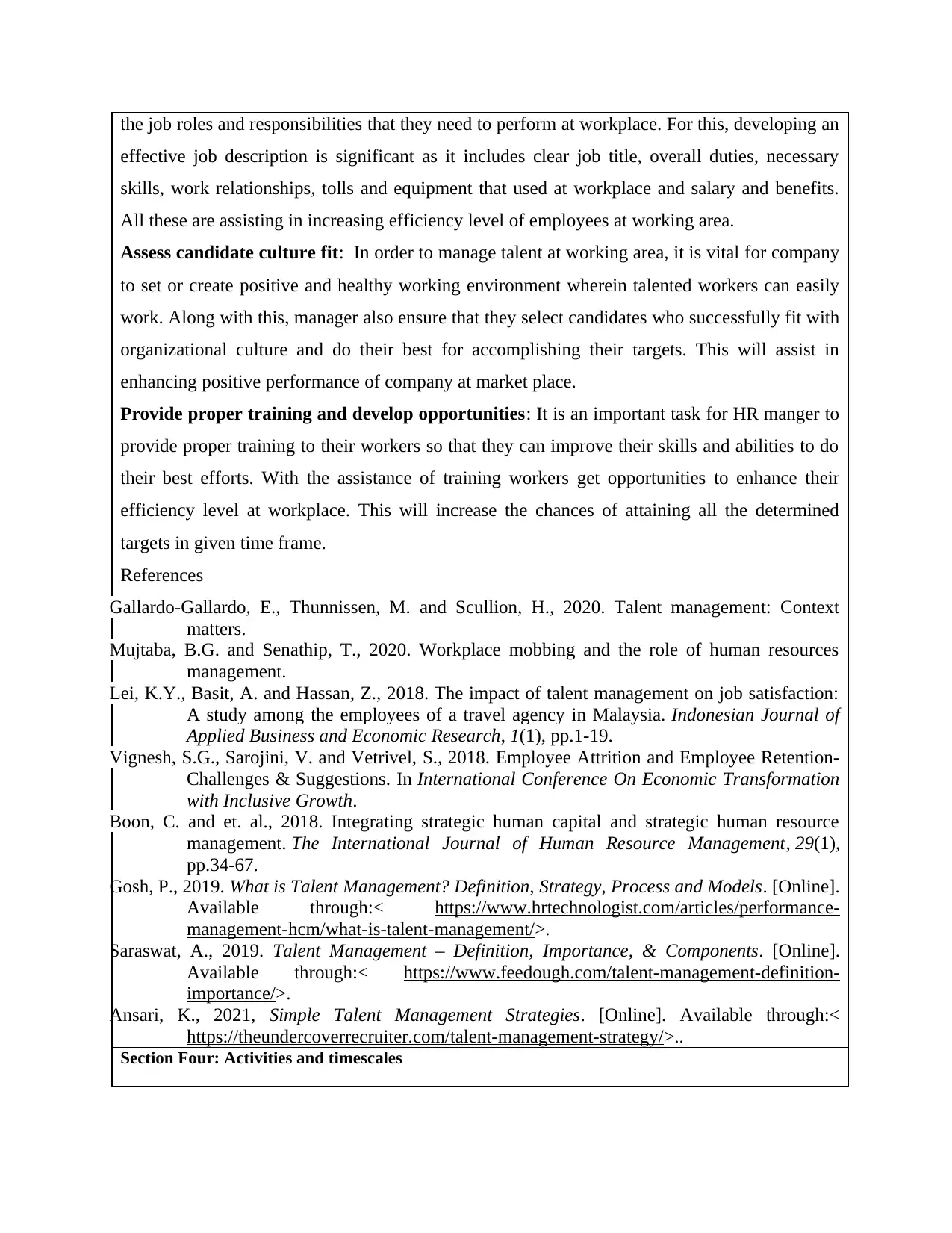
the job roles and responsibilities that they need to perform at workplace. For this, developing an
effective job description is significant as it includes clear job title, overall duties, necessary
skills, work relationships, tolls and equipment that used at workplace and salary and benefits.
All these are assisting in increasing efficiency level of employees at working area.
Assess candidate culture fit: In order to manage talent at working area, it is vital for company
to set or create positive and healthy working environment wherein talented workers can easily
work. Along with this, manager also ensure that they select candidates who successfully fit with
organizational culture and do their best for accomplishing their targets. This will assist in
enhancing positive performance of company at market place.
Provide proper training and develop opportunities: It is an important task for HR manger to
provide proper training to their workers so that they can improve their skills and abilities to do
their best efforts. With the assistance of training workers get opportunities to enhance their
efficiency level at workplace. This will increase the chances of attaining all the determined
targets in given time frame.
References
Gallardo-Gallardo, E., Thunnissen, M. and Scullion, H., 2020. Talent management: Context
matters.
Mujtaba, B.G. and Senathip, T., 2020. Workplace mobbing and the role of human resources
management.
Lei, K.Y., Basit, A. and Hassan, Z., 2018. The impact of talent management on job satisfaction:
A study among the employees of a travel agency in Malaysia. Indonesian Journal of
Applied Business and Economic Research, 1(1), pp.1-19.
Vignesh, S.G., Sarojini, V. and Vetrivel, S., 2018. Employee Attrition and Employee Retention-
Challenges & Suggestions. In International Conference On Economic Transformation
with Inclusive Growth.
Boon, C. and et. al., 2018. Integrating strategic human capital and strategic human resource
management. The International Journal of Human Resource Management, 29(1),
pp.34-67.
Gosh, P., 2019. What is Talent Management? Definition, Strategy, Process and Models. [Online].
Available through:< https://www.hrtechnologist.com/articles/performance-
management-hcm/what-is-talent-management/>.
Saraswat, A., 2019. Talent Management – Definition, Importance, & Components. [Online].
Available through:< https://www.feedough.com/talent-management-definition-
importance/>.
Ansari, K., 2021, Simple Talent Management Strategies. [Online]. Available through:<
https://theundercoverrecruiter.com/talent-management-strategy/>..
Section Four: Activities and timescales
effective job description is significant as it includes clear job title, overall duties, necessary
skills, work relationships, tolls and equipment that used at workplace and salary and benefits.
All these are assisting in increasing efficiency level of employees at working area.
Assess candidate culture fit: In order to manage talent at working area, it is vital for company
to set or create positive and healthy working environment wherein talented workers can easily
work. Along with this, manager also ensure that they select candidates who successfully fit with
organizational culture and do their best for accomplishing their targets. This will assist in
enhancing positive performance of company at market place.
Provide proper training and develop opportunities: It is an important task for HR manger to
provide proper training to their workers so that they can improve their skills and abilities to do
their best efforts. With the assistance of training workers get opportunities to enhance their
efficiency level at workplace. This will increase the chances of attaining all the determined
targets in given time frame.
References
Gallardo-Gallardo, E., Thunnissen, M. and Scullion, H., 2020. Talent management: Context
matters.
Mujtaba, B.G. and Senathip, T., 2020. Workplace mobbing and the role of human resources
management.
Lei, K.Y., Basit, A. and Hassan, Z., 2018. The impact of talent management on job satisfaction:
A study among the employees of a travel agency in Malaysia. Indonesian Journal of
Applied Business and Economic Research, 1(1), pp.1-19.
Vignesh, S.G., Sarojini, V. and Vetrivel, S., 2018. Employee Attrition and Employee Retention-
Challenges & Suggestions. In International Conference On Economic Transformation
with Inclusive Growth.
Boon, C. and et. al., 2018. Integrating strategic human capital and strategic human resource
management. The International Journal of Human Resource Management, 29(1),
pp.34-67.
Gosh, P., 2019. What is Talent Management? Definition, Strategy, Process and Models. [Online].
Available through:< https://www.hrtechnologist.com/articles/performance-
management-hcm/what-is-talent-management/>.
Saraswat, A., 2019. Talent Management – Definition, Importance, & Components. [Online].
Available through:< https://www.feedough.com/talent-management-definition-
importance/>.
Ansari, K., 2021, Simple Talent Management Strategies. [Online]. Available through:<
https://theundercoverrecruiter.com/talent-management-strategy/>..
Section Four: Activities and timescales

Activities to be carried out during the research project (e.g research,
development and analysis of ideas, writing, data collection, numerical
analysis, tutor meetings, production of final outcome, evaluation, writing
the report):
Aim and objectives
Literature review
Research Methodology
Data Collection
Data analysis
Conclusion and recommendations
Submission of final report
How long this will
take:
4
14
20
28
21
8
4
Milestone one: _____Literature review ____________
Target date (set by tutor): __02-12-20__________________
Milestone two: ______Data Collection_________________
Target date (set by tutor): _____24-02-21_________________
Gantt Chart: This refers to the time management tool used by researcher for identifying starting
and ending time of research. This chart includes different activities that will be shown as below in
graphical way. These are:
development and analysis of ideas, writing, data collection, numerical
analysis, tutor meetings, production of final outcome, evaluation, writing
the report):
Aim and objectives
Literature review
Research Methodology
Data Collection
Data analysis
Conclusion and recommendations
Submission of final report
How long this will
take:
4
14
20
28
21
8
4
Milestone one: _____Literature review ____________
Target date (set by tutor): __02-12-20__________________
Milestone two: ______Data Collection_________________
Target date (set by tutor): _____24-02-21_________________
Gantt Chart: This refers to the time management tool used by researcher for identifying starting
and ending time of research. This chart includes different activities that will be shown as below in
graphical way. These are:
⊘ This is a preview!⊘
Do you want full access?
Subscribe today to unlock all pages.

Trusted by 1+ million students worldwide
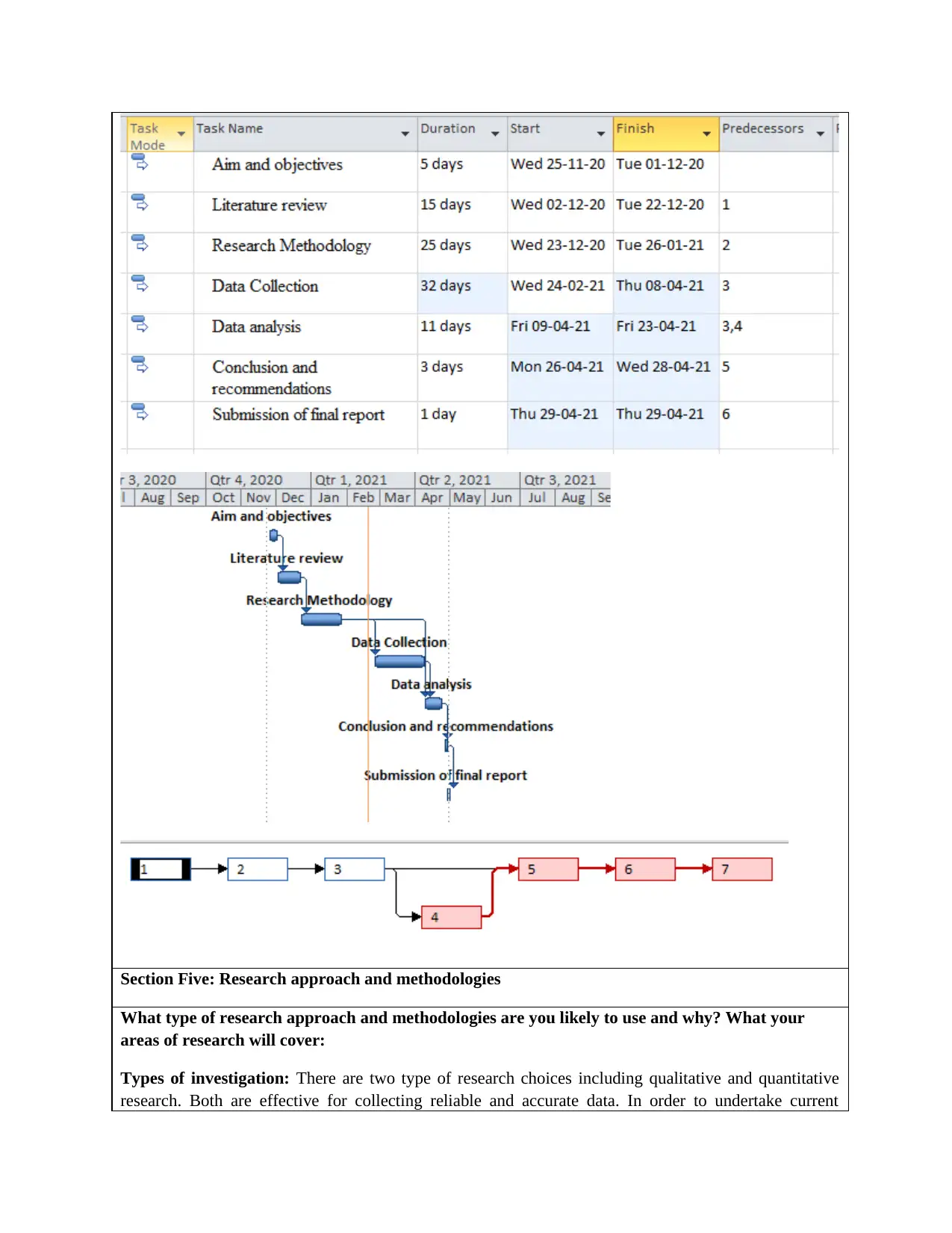
Section Five: Research approach and methodologies
What type of research approach and methodologies are you likely to use and why? What your
areas of research will cover:
Types of investigation: There are two type of research choices including qualitative and quantitative
research. Both are effective for collecting reliable and accurate data. In order to undertake current
What type of research approach and methodologies are you likely to use and why? What your
areas of research will cover:
Types of investigation: There are two type of research choices including qualitative and quantitative
research. Both are effective for collecting reliable and accurate data. In order to undertake current
Paraphrase This Document
Need a fresh take? Get an instant paraphrase of this document with our AI Paraphraser

investigation, quantitative and quantitative research choices will be used by investigator as it provides
measurable and in-depth information on the basis of specified research topic and area. With the
assistance of this, researcher can easily take right and meaningful decision at the end of the
investigation. Main purpose of selecting qualitative and quantitative research choices are it helps them in
achievement of each objective in successful manner.
Research philosophy: Interpretivism and pragmatism are two type of methods for carry out research
activities as it supports in acquiring reliable information about the specified topic and area. For carry out
present study pragmatism and interpretivisim research philosophies will be used by researcher with the
aim of understanding the view of points of selected participants towards the research aims and
objectives. Main reason behind selection of interpretivism and pragmatism research are it support in
collecting as well as evaluating of quantitative information effectively and addressing the real life issues
associated with the research aims.
Data collection: It is referring to the procedure of collected data from different respondents in order to
draw a valid conclusion within the study. Mainly, it is classified on the basis of two methods such as
primary and secondary method of data collection. Both methods will be applied by investigator to carry
out this study. In order to collect primary data, investigator prepare a structured questionnaire that
consist different close-ended questions asked from selected respondents. On the other side, literature
review is also undertaken by researcher for acquiring secondary data. Along with this, it also includes
different sources such as books, journals, articles, newspapers and many more. With the assistance of
this, researcher can easily take right decision and also draw a meaningful conclusion.
Data analysis: This refers to the process of evaluating gathered data from research analytical technique.
In order to analyse quantitative information, frequency distribution analysis is a chosen
technique. Main reason regarding the selection of such technique is it not takes maximum time
and support in evaluating of numerical information. Along with this, for evaluating qualitative
information, thematic analysis will be selected by researcher. Main reason regarding the
selection of thematic analysis is it provides qualitative data in minimum time and resources.
Sampling: It is a procedure of selected sampling size from the large number of populations in order to
acquire authentic data. Mainly, it is classified into two methods such as probabilistic and non-
probabilistic sampling techniques. As per current investigation, probabilistic sampling method will be
used in which respondents are selected as per random basis and also provide equal opportunities to be
selected to providing reliable data. By using this method, 50 employees of H&M in London will be
selected as a sample size. Along with this, non-probability sampling will also be using for selecting
sample for qualitative research. 3 managers of H&M in London will be selected for qualitative research.
Main reason about the selection of probability and non-probability samplings are it helps in selection of
appropriate number of sample size.
Comments and agreement from tutor
Comments (optional):
I confirm that the project is not work which has been or will be submitted for another
measurable and in-depth information on the basis of specified research topic and area. With the
assistance of this, researcher can easily take right and meaningful decision at the end of the
investigation. Main purpose of selecting qualitative and quantitative research choices are it helps them in
achievement of each objective in successful manner.
Research philosophy: Interpretivism and pragmatism are two type of methods for carry out research
activities as it supports in acquiring reliable information about the specified topic and area. For carry out
present study pragmatism and interpretivisim research philosophies will be used by researcher with the
aim of understanding the view of points of selected participants towards the research aims and
objectives. Main reason behind selection of interpretivism and pragmatism research are it support in
collecting as well as evaluating of quantitative information effectively and addressing the real life issues
associated with the research aims.
Data collection: It is referring to the procedure of collected data from different respondents in order to
draw a valid conclusion within the study. Mainly, it is classified on the basis of two methods such as
primary and secondary method of data collection. Both methods will be applied by investigator to carry
out this study. In order to collect primary data, investigator prepare a structured questionnaire that
consist different close-ended questions asked from selected respondents. On the other side, literature
review is also undertaken by researcher for acquiring secondary data. Along with this, it also includes
different sources such as books, journals, articles, newspapers and many more. With the assistance of
this, researcher can easily take right decision and also draw a meaningful conclusion.
Data analysis: This refers to the process of evaluating gathered data from research analytical technique.
In order to analyse quantitative information, frequency distribution analysis is a chosen
technique. Main reason regarding the selection of such technique is it not takes maximum time
and support in evaluating of numerical information. Along with this, for evaluating qualitative
information, thematic analysis will be selected by researcher. Main reason regarding the
selection of thematic analysis is it provides qualitative data in minimum time and resources.
Sampling: It is a procedure of selected sampling size from the large number of populations in order to
acquire authentic data. Mainly, it is classified into two methods such as probabilistic and non-
probabilistic sampling techniques. As per current investigation, probabilistic sampling method will be
used in which respondents are selected as per random basis and also provide equal opportunities to be
selected to providing reliable data. By using this method, 50 employees of H&M in London will be
selected as a sample size. Along with this, non-probability sampling will also be using for selecting
sample for qualitative research. 3 managers of H&M in London will be selected for qualitative research.
Main reason about the selection of probability and non-probability samplings are it helps in selection of
appropriate number of sample size.
Comments and agreement from tutor
Comments (optional):
I confirm that the project is not work which has been or will be submitted for another

qualification and is appropriate.
Agreed: ________________ (name)_______________ Date ______________
Comments and agreement form project proposal checker( IV sampling)
Comments (Optional):
I confirm that the project is appropriate.
Agreed /Disagree: (Name of the IV) Date
Questionnaire
Quantitative questions
QUESTONNAIRE
Q1) Do you understanding the basic concept of talent management in organisation?
a) Yes
b) No
Q2) What is the basic role played by human resource department in the process of talent-
management?
a) Development of a competent workforce
b) Enhancing employee individual performance
c) Hiring of right employee at right job position
Q3) What is the main strategy based on which talent-management process can be
implemented in organisation?
a) Use of training and development measures
b) Proper motivation techniques
c) Performance measurement
Q4) In which manner, talent management impact on the organisational performance?
a) Positive manner
b) Negative manner
Agreed: ________________ (name)_______________ Date ______________
Comments and agreement form project proposal checker( IV sampling)
Comments (Optional):
I confirm that the project is appropriate.
Agreed /Disagree: (Name of the IV) Date
Questionnaire
Quantitative questions
QUESTONNAIRE
Q1) Do you understanding the basic concept of talent management in organisation?
a) Yes
b) No
Q2) What is the basic role played by human resource department in the process of talent-
management?
a) Development of a competent workforce
b) Enhancing employee individual performance
c) Hiring of right employee at right job position
Q3) What is the main strategy based on which talent-management process can be
implemented in organisation?
a) Use of training and development measures
b) Proper motivation techniques
c) Performance measurement
Q4) In which manner, talent management impact on the organisational performance?
a) Positive manner
b) Negative manner
⊘ This is a preview!⊘
Do you want full access?
Subscribe today to unlock all pages.

Trusted by 1+ million students worldwide
1 out of 44
Related Documents
Your All-in-One AI-Powered Toolkit for Academic Success.
+13062052269
info@desklib.com
Available 24*7 on WhatsApp / Email
![[object Object]](/_next/static/media/star-bottom.7253800d.svg)
Unlock your academic potential
Copyright © 2020–2025 A2Z Services. All Rights Reserved. Developed and managed by ZUCOL.





